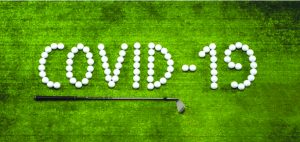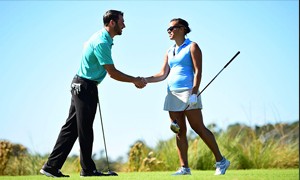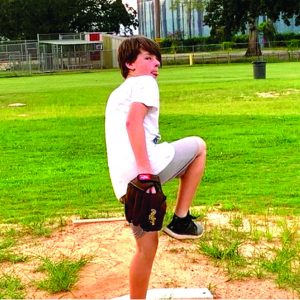What Does The Future Hold For The Golf Industry After COVID-19?
 It started as a minor news story out of China, and for weeks, it stayed there. Then, reports of the deadly new virus grew ominous with various experts saying the fatality rate of the new virus was over three percent. Early models from Imperial College in the United Kingdom predicted that 2.2 million people would die in the United States if no mitigation procedures were undertaken and 1.1 million would die even if they were.
The COVID-19 coronavirus is not only the biggest story of 2020, it will undoubtedly be one of the biggest stories of the 21st century when the history books are written. The virus has upended daily life all over the planet. It wasn’t long before government officials worldwide began imposing “lockdowns” in an effort to combat the virus. People were ordered to stay home and venture out to only “essential” businesses that provided what were considered the necessities of life, such as food and personal items. Businesses deemed “non-essential” were ordered closed, putting tens of millions of Americans out of work.
Unfortunately, the sport of golf was deemed non-essential by many U.S. governors, and courses by the thousands lay idle. This, despite evidence that being outdoors was one of the best ways to not get the virus. This, despite the fact that the game of golf requires no one to get closer than six feet of another person (one of the mandates of “social distancing”), or that no one had to touch anything that someone else touched. However, other, more enlightened governors realized the benefits of golf and deemed courses essential businesses. These courses were allowed to remain open, with many choosing to alter some aspects. Namely, bunker rakes were removed and pool noodles were inserted in the hole so that retrieving a ball from the hole did not require removal of the flagstick or touching the bottom part of the flagstick in removing the ball from the cup. Water coolers were also taken away.
Many private clubs limited play to members only, with no guests or outside play allowed. Some courses closed their pro shops, taking payment outside and not accepting cash. One-rider-to-a-cart became the norm, and tee times spaced out at 15-minute intervals were implemented at many facilities.
Course dining rooms and clubhouses were closed. With economic damage mounting, states across the U.S. realized that they had to open businesses back up or risk a catastrophe on their hands that would eclipse any of the damage that the virus itself may have imposed – and that point may well have already been passed. Time will tell if the economy will recover or if tens of millions of lives will be destroyed in the sense of mental well being and financial health.
Scientific information is now coming in, showing that not only the shuttering of golf courses was completely unnecessary, but that many of the policies that courses implemented in the name of safety were virtually useless in combating the spread of infection. The Centers for Disease Control (CDC) recently stated that the virus is not easily spread through touch points indoors, much less outdoors. Golf Digest quoted Dr. Charles Prober, professor of immunology and microbiology at Stanford University, as saying, “[Handling the flagstick] is
an extraordinarily ineffective way of getting the disease.” According to Dr. Prober, a series of highly unlikely events would have to occur. First, someone sick with the disease would have to be playing. Second, that person would have to get the virus on their hands through coughing, sneezing, or otherwise transferring body fluids on their hands. Third, they would then have to touch the flagstick soon after.
Fourth, the next person to touch the flagstick would have to touch it in the same exact place as the infected person – assuming the virus was still on the flagstick (more on that later). Fifth, that next person would then have to introduce the virus into themselves by touching their eyes, nose, or mouth within a few minutes of touching the flagstick. In other words, as Dr. Prober pointed out, this highly improbable.
Dr. Amesh Adalja, from Johns Hopkins University, said on golfdigest.com that retrieving a ball from a hole presents “very minimal risks in those types of situations. You can dream up any kind of odd situation where the virus transmits in these special circumstances, but that wouldn’t be something I would be worried about.”
And since Dr. Prober and Dr. Adalja made these statements, new information has come out that the coronavirus doesn’t fare well in sunlight. Willliam Bryan of the Department of Homeland Security (DHS) said DHS research showed the virus having a half-life of two minutes in sunlight. This means that a maximum of 1/32 of the virus would be left on an outdoor surface after 10 minutes of sunlight
exposure. Therefore, it would seem handling a bunker rake is extremely safe, as well.
Dr. Ezekiel Emanual from the University of Pennsylvania, speaking on the television show Morning Joe, said that in order to get infected, “You need to see a prolonged amount of virus over a period of time. That happens indoors, not outdoors.” He also pointed out that there have been “very few” instances of people getting infected outdoors.
With all of that as the background, the headline of this article asks what’s in store for the future of the golf industry. Right now, signs are highly encouraging. Courses that were under lockdown have seen large waves of golfers. Even courses that were never closed have reported a decent increase in rounds played. Golf retail stores are also seeing business return to near normal, and on many days, exceed their corporate offices’ expectations. That’s not only good news for the retail operations, but also for the club manufacturers and suppliers of these stores.
Demographically, golf is currently faring well. Most golfers have either secure investment income or job security that withstood the economic shutdowns, so the majority of golfers should continue to play. The wild card is how soon the tens of millions of unemployed Americans return to the workforce, as they represent a smaller but significant portion of the golfing population. It would be foolish to venture a guess at this early stage, but hopefully the majority will not be without jobs for long.
The early models reporting that over a million Americans would lose their lives were egregiously wrong, as was the assumption the infection fatality rate was over three percent. While current research from a number of sources, including the Stanford University School of Medicine, the University of Southern California and the University of Bonn in Germany, as well as antibody studies done in Colorado, Massachusetts and New York all show the actual infection fatality rate is likely to be under one-half of one percent, the virus is still a very serious matter. While, as the saying goes, “so far, so good,” the golf industry needs to keep on its toes and continue to promote the game and make people feel confident that they can play without any significant risk.
It started as a minor news story out of China, and for weeks, it stayed there. Then, reports of the deadly new virus grew ominous with various experts saying the fatality rate of the new virus was over three percent. Early models from Imperial College in the United Kingdom predicted that 2.2 million people would die in the United States if no mitigation procedures were undertaken and 1.1 million would die even if they were.
The COVID-19 coronavirus is not only the biggest story of 2020, it will undoubtedly be one of the biggest stories of the 21st century when the history books are written. The virus has upended daily life all over the planet. It wasn’t long before government officials worldwide began imposing “lockdowns” in an effort to combat the virus. People were ordered to stay home and venture out to only “essential” businesses that provided what were considered the necessities of life, such as food and personal items. Businesses deemed “non-essential” were ordered closed, putting tens of millions of Americans out of work.
Unfortunately, the sport of golf was deemed non-essential by many U.S. governors, and courses by the thousands lay idle. This, despite evidence that being outdoors was one of the best ways to not get the virus. This, despite the fact that the game of golf requires no one to get closer than six feet of another person (one of the mandates of “social distancing”), or that no one had to touch anything that someone else touched. However, other, more enlightened governors realized the benefits of golf and deemed courses essential businesses. These courses were allowed to remain open, with many choosing to alter some aspects. Namely, bunker rakes were removed and pool noodles were inserted in the hole so that retrieving a ball from the hole did not require removal of the flagstick or touching the bottom part of the flagstick in removing the ball from the cup. Water coolers were also taken away.
Many private clubs limited play to members only, with no guests or outside play allowed. Some courses closed their pro shops, taking payment outside and not accepting cash. One-rider-to-a-cart became the norm, and tee times spaced out at 15-minute intervals were implemented at many facilities.
Course dining rooms and clubhouses were closed. With economic damage mounting, states across the U.S. realized that they had to open businesses back up or risk a catastrophe on their hands that would eclipse any of the damage that the virus itself may have imposed – and that point may well have already been passed. Time will tell if the economy will recover or if tens of millions of lives will be destroyed in the sense of mental well being and financial health.
Scientific information is now coming in, showing that not only the shuttering of golf courses was completely unnecessary, but that many of the policies that courses implemented in the name of safety were virtually useless in combating the spread of infection. The Centers for Disease Control (CDC) recently stated that the virus is not easily spread through touch points indoors, much less outdoors. Golf Digest quoted Dr. Charles Prober, professor of immunology and microbiology at Stanford University, as saying, “[Handling the flagstick] is
an extraordinarily ineffective way of getting the disease.” According to Dr. Prober, a series of highly unlikely events would have to occur. First, someone sick with the disease would have to be playing. Second, that person would have to get the virus on their hands through coughing, sneezing, or otherwise transferring body fluids on their hands. Third, they would then have to touch the flagstick soon after.
Fourth, the next person to touch the flagstick would have to touch it in the same exact place as the infected person – assuming the virus was still on the flagstick (more on that later). Fifth, that next person would then have to introduce the virus into themselves by touching their eyes, nose, or mouth within a few minutes of touching the flagstick. In other words, as Dr. Prober pointed out, this highly improbable.
Dr. Amesh Adalja, from Johns Hopkins University, said on golfdigest.com that retrieving a ball from a hole presents “very minimal risks in those types of situations. You can dream up any kind of odd situation where the virus transmits in these special circumstances, but that wouldn’t be something I would be worried about.”
And since Dr. Prober and Dr. Adalja made these statements, new information has come out that the coronavirus doesn’t fare well in sunlight. Willliam Bryan of the Department of Homeland Security (DHS) said DHS research showed the virus having a half-life of two minutes in sunlight. This means that a maximum of 1/32 of the virus would be left on an outdoor surface after 10 minutes of sunlight
exposure. Therefore, it would seem handling a bunker rake is extremely safe, as well.
Dr. Ezekiel Emanual from the University of Pennsylvania, speaking on the television show Morning Joe, said that in order to get infected, “You need to see a prolonged amount of virus over a period of time. That happens indoors, not outdoors.” He also pointed out that there have been “very few” instances of people getting infected outdoors.
With all of that as the background, the headline of this article asks what’s in store for the future of the golf industry. Right now, signs are highly encouraging. Courses that were under lockdown have seen large waves of golfers. Even courses that were never closed have reported a decent increase in rounds played. Golf retail stores are also seeing business return to near normal, and on many days, exceed their corporate offices’ expectations. That’s not only good news for the retail operations, but also for the club manufacturers and suppliers of these stores.
Demographically, golf is currently faring well. Most golfers have either secure investment income or job security that withstood the economic shutdowns, so the majority of golfers should continue to play. The wild card is how soon the tens of millions of unemployed Americans return to the workforce, as they represent a smaller but significant portion of the golfing population. It would be foolish to venture a guess at this early stage, but hopefully the majority will not be without jobs for long.
The early models reporting that over a million Americans would lose their lives were egregiously wrong, as was the assumption the infection fatality rate was over three percent. While current research from a number of sources, including the Stanford University School of Medicine, the University of Southern California and the University of Bonn in Germany, as well as antibody studies done in Colorado, Massachusetts and New York all show the actual infection fatality rate is likely to be under one-half of one percent, the virus is still a very serious matter. While, as the saying goes, “so far, so good,” the golf industry needs to keep on its toes and continue to promote the game and make people feel confident that they can play without any significant risk.









 By Thomas T Wartelle WGTF Master Golf Teaching Professional Washington, Louisiana
The golf swing is a series of movements that takes a PGA Tour professional approximately 0.75 seconds for the backswing and 0.25 seconds
for the downswing, for a grand total of 1 second! The interesting thing is the 3:1 ratio of backswing to downswing. Studies have shown that the great players all had the similar 3:1 ratio. This certainly proves that timing and sequencing of the golf swing plays a big factor in long-term success. Interestingly, it has been found that most amateur golfers’ backswings are actually too slow and out of sequence to be consistently successful at impact.
Now, from a biomechanics standpoint, this is often caused by a backswing sequence that is just not as efficient as a tour player’s. A major
flaw often overlooked in amateur golfers is how the centers of their torso and pelvis move during the swing. The tour pro moves his centers slightly away from the target early in the backswing, like all athletic motions of throwing or swinging. This “early loading” occurs before the club shaft is parallel to the ground. It is typically only less than 1 inch. By the time a tour pro reaches the top of the backswing, their torso and pelvis re-center to their original position at address. One of the most interesting things is early in the downswing, their centers have moved ahead of the ball. This produces an optimal position to deliver an efficient and powerful impact.
High-handicap golfers tend to be much less efficient in their backswings. They do not do these sequences properly, or they do them too
late. Often, they continue to try to load away from the target late into the backswing. They feel like moving away from the target and trying
to maximize their turn creates more power. In reality, it just makes them later in getting their torso and pelvis centers into the proper downswing sequence. By trying to load too far and too late on the backswing, they end up working hard to try to “save” the shot. There is just not enough time on the downswing for them to deliver the club to a successful impact position.
Now, how do we relate this to instruction? Many instructors are using really great modern technology to pinpoint the flaws of a golf swing. Here is where instructors get it wrong: With all of their technology, pressure plates, launch monitors and metrics, they fail to convey the proper message to the student. Remember, the golf swing happens in a mere second from the move away until impact. Think about it: As a kid, did you analyze where your torso and pelvis centers were located when you tried to hit a baseball? Did you think about your weight distribution when you threw a ball? Did you think about your center of gravity when you started to jump?
Some people have more athletic awareness than others; however, most people have an innate ability to achieve some level of a golf swing goal. Granted, there can be some limitations, but mostly these innate abilities need to be activated or woken up. There are many thoughts and drills that one can use to achieve better swing sequencing. As an instructor, I try to use more active drills and feelings to achieve swing goals.
For example and thinking out of the box, there is my son, who is an up-and-coming junior golfer. He was not quite getting his swing sequencing where he wanted to be. I simply brought out a baseball and glove. As we began to throw, I encouraged him to throw harder and harder. The next time he hit balls, he instantly felt all of the swing sequencing described earlier. This positive result happened without rattling off metrics and going into a long biophysical explanation to the student. After all, golf is a results-oriented endeavor, and most students are looking for results.
As an instructor, I encourage the use of technology. But more importantly, learn how to apply the technology to help you convey the
message through active teaching. Technology is great, but not always really needed. A truly trained eye and analysis of the ball strike can discern most impact flaws. Technology only quantifies exact numbers. Students are generally not interested in the numbers and biomechanics. They are interested in hitting solid shots and playing better.
By Thomas T Wartelle WGTF Master Golf Teaching Professional Washington, Louisiana
The golf swing is a series of movements that takes a PGA Tour professional approximately 0.75 seconds for the backswing and 0.25 seconds
for the downswing, for a grand total of 1 second! The interesting thing is the 3:1 ratio of backswing to downswing. Studies have shown that the great players all had the similar 3:1 ratio. This certainly proves that timing and sequencing of the golf swing plays a big factor in long-term success. Interestingly, it has been found that most amateur golfers’ backswings are actually too slow and out of sequence to be consistently successful at impact.
Now, from a biomechanics standpoint, this is often caused by a backswing sequence that is just not as efficient as a tour player’s. A major
flaw often overlooked in amateur golfers is how the centers of their torso and pelvis move during the swing. The tour pro moves his centers slightly away from the target early in the backswing, like all athletic motions of throwing or swinging. This “early loading” occurs before the club shaft is parallel to the ground. It is typically only less than 1 inch. By the time a tour pro reaches the top of the backswing, their torso and pelvis re-center to their original position at address. One of the most interesting things is early in the downswing, their centers have moved ahead of the ball. This produces an optimal position to deliver an efficient and powerful impact.
High-handicap golfers tend to be much less efficient in their backswings. They do not do these sequences properly, or they do them too
late. Often, they continue to try to load away from the target late into the backswing. They feel like moving away from the target and trying
to maximize their turn creates more power. In reality, it just makes them later in getting their torso and pelvis centers into the proper downswing sequence. By trying to load too far and too late on the backswing, they end up working hard to try to “save” the shot. There is just not enough time on the downswing for them to deliver the club to a successful impact position.
Now, how do we relate this to instruction? Many instructors are using really great modern technology to pinpoint the flaws of a golf swing. Here is where instructors get it wrong: With all of their technology, pressure plates, launch monitors and metrics, they fail to convey the proper message to the student. Remember, the golf swing happens in a mere second from the move away until impact. Think about it: As a kid, did you analyze where your torso and pelvis centers were located when you tried to hit a baseball? Did you think about your weight distribution when you threw a ball? Did you think about your center of gravity when you started to jump?
Some people have more athletic awareness than others; however, most people have an innate ability to achieve some level of a golf swing goal. Granted, there can be some limitations, but mostly these innate abilities need to be activated or woken up. There are many thoughts and drills that one can use to achieve better swing sequencing. As an instructor, I try to use more active drills and feelings to achieve swing goals.
For example and thinking out of the box, there is my son, who is an up-and-coming junior golfer. He was not quite getting his swing sequencing where he wanted to be. I simply brought out a baseball and glove. As we began to throw, I encouraged him to throw harder and harder. The next time he hit balls, he instantly felt all of the swing sequencing described earlier. This positive result happened without rattling off metrics and going into a long biophysical explanation to the student. After all, golf is a results-oriented endeavor, and most students are looking for results.
As an instructor, I encourage the use of technology. But more importantly, learn how to apply the technology to help you convey the
message through active teaching. Technology is great, but not always really needed. A truly trained eye and analysis of the ball strike can discern most impact flaws. Technology only quantifies exact numbers. Students are generally not interested in the numbers and biomechanics. They are interested in hitting solid shots and playing better.
 Learn active drills and exercises that can help each student of yours reach their maximum potential. Keep informed and keep learning new
techniques. However, pay homage to the past, as nothing is really new in athletic motion. We just learn different ways to convey the message. I recently learned a new thing too: I need a better catcher’s mitt and protection from my son’s lefthanded fastball!
Learn active drills and exercises that can help each student of yours reach their maximum potential. Keep informed and keep learning new
techniques. However, pay homage to the past, as nothing is really new in athletic motion. We just learn different ways to convey the message. I recently learned a new thing too: I need a better catcher’s mitt and protection from my son’s lefthanded fastball!